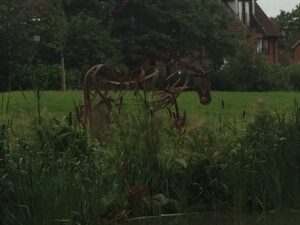Herons, the canal boat and Milton Keynes landscaping
Quirk lost his phone this week. Last week he lost his lovely new glasses. I got to near the agreed venue Friday night and then rang him up because I couldn’t find it. I was speaking to the security guard at the local Sainsburys where he had left his phone. I went to the boat. In the end we had to walk back from our Saturday destination near Peartree Bridge to collect the cars and redistribute them – mine to Stoke Hammond. We need to get to a boatyard where we might find someone to deal with the bilge pump because there was a lot of water in the back this week. The kitchen and bathroom sinks are not draining and there is no hot water in either, and someone pointed out that we may have a diesel leak. It’s stressful when neither of us are competent to deal with these things.
I am in love with canal side herons. I have never seen so many herons in my life before. Very rarely we would get one visit the pond in the garden but on the canal I see 2-3 every day and they let you get so close. They are not beautiful like a kingfisher is beautiful – I saw a flash of one this weekend – but they have presence.
I have also been so so impressed with the landscaping around the canal at Milton Keynes. All these years of living in Luton and never seeing it. I had to google to find out the genius behind it.
The Grand Union Canal is another green route (and demonstrates the level geography of the area – there is just one minor lock in its entire 10-mile (16 km) meandering route through from the southern boundary near Fenny Stratford to the “Iron Trunk” aqueduct over the Ouse at Wolverton at its northern boundary). The initial park system was planned by Peter Youngman (Chief Landscape Architect), who also developed landscape precepts for all development areas: groups of grid squares were to be planted with different selections of trees and shrubs to give them distinct identities. The detailed planning and landscape design of parks and of the grid roads was evolved under the leadership of Neil Higson, who from 1977 took over from Youngman.
In a national comparison of urban areas by open space available to residents, Milton Keynes ranked highest in the UK.
‘City in the forest’
The Development Corporation’s original design concept aimed for a “forest city” and its foresters planted millions of trees from its own nursery in Newlands in the following years. Parks, lakes and green spaces cover about 25% of Milton Keynes; as of 2018, there are 22 million trees and shrubs in public open spaces. When the Development Corporation was being wound up, it transferred the major parks, lakes, river-banks and grid-road margins to the Parks Trust, a charity which is independent of the municipal authority. MKDC endowed the Parks Trust with a portfolio of commercial properties, the income from which pays for the upkeep of the green spaces. As of 2018, approximately 25% of the urban area is parkland or woodland.
It was a privilege to cruise through and see it.

Noah is now on the boat free when we are moving in his life jacket and has been very good. I think he likes the wind in his hair.
